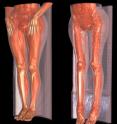Researchers discover molecular basis of a form of muscular dystrophy
A team of French and German researchers report in the May 2008 print issue of The FASEB Journal (http://www.fasebj.org) that people with limb-girdle muscular dystrophy are missing a protein called c-FLIP, which the body uses to prevent the loss of muscle tissue. By targeting the cellular and molecular mechanisms responsible for creating this protein, scientists could develop new drugs to stop muscle wasting from limb-girdle muscular dystrophy and other conditions. “Unfortunately, rare diseases like limb-girdle muscular dystrophy don’t get the attention or funding they deserve,” said Gerald Weissmann, M.D., Editor-in-Chief of The FASEB Journal. “I hope that the breakthrough described in this study—the discovery of what regulates a protein that determines which muscle tissue stays and goes in our bodies—will lead to a range of new drugs for this form of muscular dystrophy and many others.”
To identify c-FLIP as a culprit in limb-girdle muscular dystrophy, the researchers used tissue from human biopsies to analyze the molecular pathways involved at each step of the disorder’s progression. The researchers found that the c-FLIP protein, which is responsible for blocking the death of muscle cells, is not produced as it should in people with limb-girdle muscular dystrophy, and that the creation of the c-FLIP protein is controlled by another protein called calpain-3. According to the authors, this finding may have implications for other types of muscular dystrophy and other situations that cause the death of muscle fibers, such as long-term immobilization, denervation, aging, or cachexia.
“Limb-girdle muscular dystrophy is a rare and devastating condition that robs people of movements that the rest of us take for granted,” Weissmann added. “Fortunately, this study should provide researchers with a much-needed target for developing drugs to treat at least one of these conditions.”
According to the U.S. Muscular Dystrophy Association, limb-girdle muscular dystrophy is a group of disorders affecting voluntary muscles around the hips and shoulders, and it is caused by mutations in at least 15 genes responsible for making proteins needed for normal muscle function. As the disease progresses, people with limb-girdle muscular dystrophy may lose their ability to walk, get in and out of chairs, comb their hair, and feed themselves.
Source: Federation of American Societies for Experimental Biology
Other sources
- Muscular dystrophy type linked to missing protein: studyfrom PhysorgThu, 1 May 2008, 21:07:13 UTC
- Researchers Discover Molecular Basis Of A Form Of Muscular Dystrophyfrom Science DailyWed, 30 Apr 2008, 18:55:15 UTC
